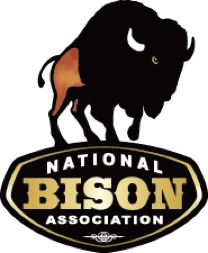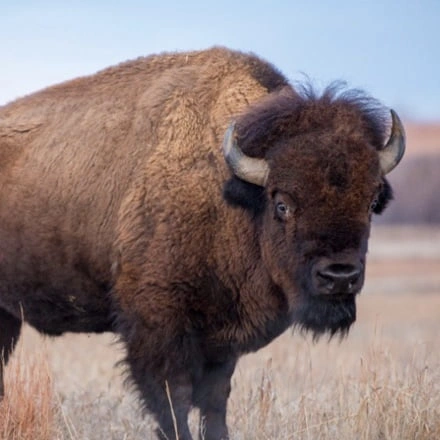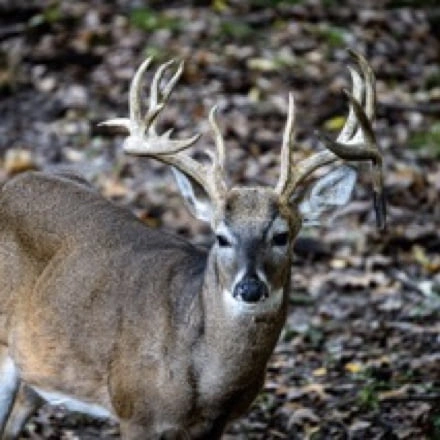Frequently Asked Questions
- Should I have my bison USDA inspected?
- When should I order?
- How should I order?
- When can I get my meat?
- Where and when can I get my animal slaughtered?
- How much meat can I expect from a whole bison?
- Bison meat is nutritious and tasty
- Cooking bison meat
- Why bison meat is so expensive?
- Where our bison meat is sold and served?
Should I have my bison USDA inspected?
If you purchase a live animal from us for slaughter, there is no real advantage to having your bison federally inspected. USDA inspection is only required if you intend to sell meat as a retail product.
When should I order?
We recommend that you reserve your animal early in the season or we may be out of stock for the year. Our regular customers, restaurants and groceries, take precedence. Whole animals are sold on a first-come basis. Remember that this takes time and we can't just whip another one up for you on the spot. Make your arrangements as early as possible.
How should I order?
You first need to contact us. We recommend that you visit our farm in person to make your arrangements to avoid any confusion or misunderstanding. However, you can always email info@harlanfarms.com too.
When can I get my meat?
We generally only harvest animals during the month of September, thus it is important to reserve your bison early to insure we have sufficient meat and/or animals to accommodate you. Although we will slaughter animals at other times of the year by special order, we find September to be the best time to harvest grass-fed and finished animals after they have been feeding on nutritious lush green pasture for several months.
Where and when can I get my animal slaughtered?
If you do not need your meat USDA inspected then we can take it anywhere. However, bison are large wild animals and not all processing plants can or will handle these animals. Because of the difficulties in dealing with these animals, you cannot usually just take them to a processing plant as you would a domestic steer; you generally need to make special arrangements in advance. Again, plan early. Make sure the plant has the facilities to handle bison. Noble Meat Company is the closest processor to the farm.
How much meat can I expect from a whole bison?
The hanging hot weight is what is left after you remove the parts that are inedible like the hide, feet, head, some of the bones and most of the innards. The dressing percentage for most bison is about 56%, lower than beef because of their heavy hide and head. Most grass-fed bison will weigh between 750 and 850 pounds at 25-30 months of age (grain fed animals will weigh more).
As an example, a 25-30 month bison weighing 800 lbs. would "dress out" or have a hanging hot weight of about 448 lbs. (800 x 0.56). Of that hanging hot weight, you take home the finished cuts or "yield" which is generally 50% to 60% of the hanging hot weight (because of the lean meat, bison have a higher yield than beef). Thus, from that 800 lb. animal you should get about 250-300 lbs. cut and packaged for your freezer. This will vary depending on how you want your meat processed; for example, boneless would have a lower yield than bone-in cuts. All meat is vacuum sealed for safe and extended freezer time to protect meat from freezer burn.
Bison are processed and cut a little different than beef for a variety of reasons. Bison have an extra rib and you cannot get a hump roast off a beef cow. From the processed meat, about 17% will be steaks, 55% will be ground bison, 25% will be roasts (which can also be ground or stew meat if roasts are not desired), and 3% will be other (short ribs, shanks, soup bones, etc).
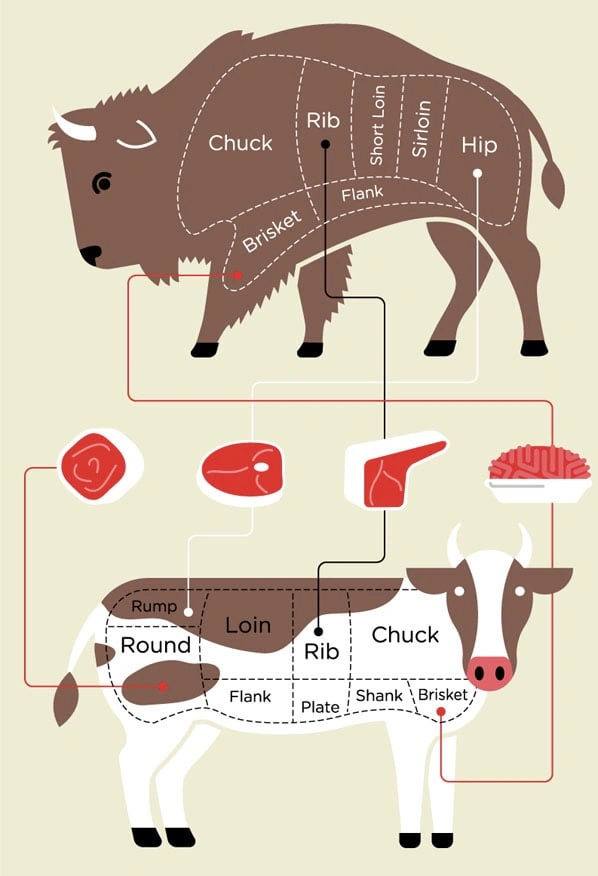
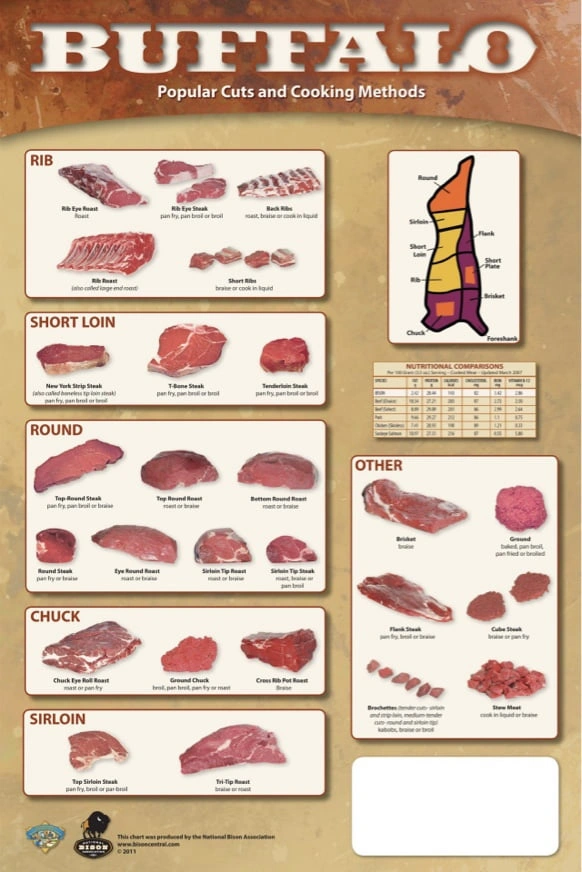
If you choose standard processing and cuts, you could expect to get approximately the following cuts and quantities (Halves would get proportionately less of the below amounts):
- Tenderloin filets – approx. 4-6 lbs.
- Strip loin steaks – approx. 8-10 lbs.
- Ribeye steaks – approx. 9-12 lbs.
- Sirloin Steaks – approx. 12-16 lbs.
- Flank/Skirt Steaks - approx. 1-2 lbs
- Chuck Roast – approx. 16-10 lbs.
- Round Roast - approx. 7-10 lbs.
- Hump Roast - approx. 12-15 lbs.
- Brisket – approx. 8-10 lbs.
- Back and Short Ribs – approx. 6-8 lbs.
- Stew Meat – approx. 12-16 lbs.
- Oxtail - approx. <1 lb.
- Marrow/Soup bones - approx, 20-22 lbs.
- Buffalo Fries (oysters) - approx. 1-2 lbs.
- Ground Burger – approx. 140-160 lbs.
This will require approximately 8-10 cu. ft. of freezer space & I would recommend this option: https://www.homedepot.com/p/Magic-Chef-8-7-cu-ft-Manual-Defrost- Chest-Freezer-in-White-HMCF9W3/313864036
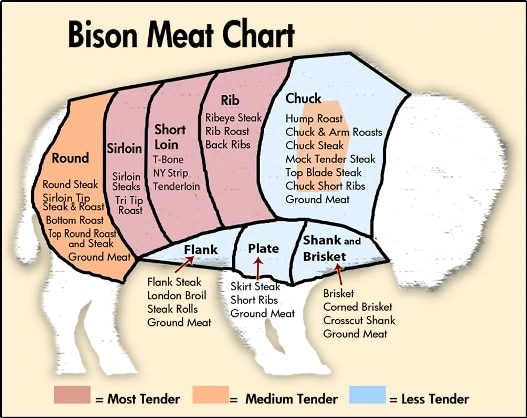
Bison meat is nutritious and tasty
All of our animals are pasture-raised, grass-fed, and grass finished without any antibiotics or hormones ensuring the highest quality meats and nutrition (not to mention great taste). We are committed to raising our bison as naturally as possible, the way nature intended, to produce flavorful, healthy meat and to the humane and sustainable raising of the North American bison. People who choose to enjoy the natural, delicious and healthy option to eat bison meat are helping to preserve bison and enjoy the health benefits.
While technically these meat animals should be called North American Bison, hence Bison meat, the general public knows these animals as North American Buffalo and the meat as Buffalo Meat. Today's animals, which are not endangered species are also not the chewy, range-fed animals of decades ago. A cousin of commercial beef, this red meat has a flavor reminiscent of beef, yet with a more robust flavor. A flavor really great on an open flame grill. Buffalo is a sweeter meat than beef, with higher protein and flavor, together with more of the important minerals we all need. There is no hint of a "gamey" taste!
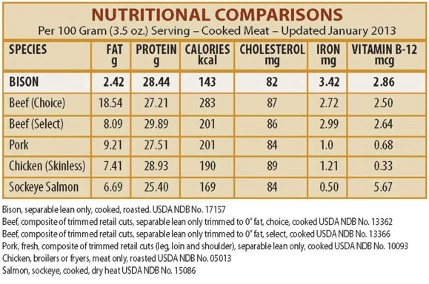
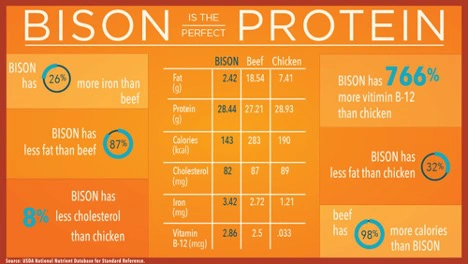
Bison meat is a highly nutrient dense food because of the proportion of protein, fat, mineral, and fatty acids to its caloric value. According to the USDA, bison is clearly the better choice with significantly less fat and calories, less cholesterol and higher amounts of protein, iron and vitamin B-12 than beef, pork, chicken and salmon. When grass-fed and finished, bison meat has a yellow-tinged fat with a stronger flavor than grain-fed animals and nutritionally a better source of Omega 3 fatty acids. Bison meat is also a great source of numerous vitamins and minerals. It is high in B12, potassium, iron, zinc, copper and selenium, while lower in sodium, calories and cholesterol. Bison meat cuts are similar to beef with all your favorite cuts present on a buffalo as well. The only real difference is the amount of fat. Since buffalo are generally less fatty than beef, cooking time is a bit faster, and it is always better to have the meat more on the rare end of the scale. Less fat in turn means more protein per ounce. Protein is more filling than fat, so the serving portions of buffalo meat can be a bit smaller yet they will still leave you satisfied.
Integrating bison into your weekly meal plan has obvious health benefits and ensures you are getting the best protein possible. Experience no guilt only the delicious goodness with the protein powerhouse only bison can deliver!
Cooking bison meat
Bison is similar to beef and is cooked much the same way with a few exceptions. Bison meat tends to have a darker red color than beef, is very low in fat and cholesterol and high in protein, vitamins, and minerals. Compared to beef, Bison meat tends to have a fuller, richer (sweet) flavor; it is not "gamey" or wild tasting.
Because it is very lean (90-95%), the meat will cook much faster than beef. Because it cooks so much faster, caution needs to be taken not to overcook the meat. Overcooked bison will be like shoe leather and may attain a liver-like taste due to the high iron content. Whether a burger or a steak, bison meat should never be cooked beyond medium. Medium rare to rare is recommended. If you or your customers like well-done meat, it is best not to serve bison.
Since bison is lower in fat (which acts as an insulator) than other meats, it is easily overcooked. Large pieces of bison, such as roasts are generally cooked at a lower temperature than similar cuts of beef. Ground bison meat should be cooked to an internal temperature of no more than 160oF and the juices should be clear and not read. Roasts and steaks should be cooked to an internal temperature of 145oF (medium rare) or 160oF (medium) at the most. The oven should be set at around 275oF.
Some tips:
When broiling, move the broiler rack away from the heat about a notch lower than with beef. Expect a bison steak to cook one third (1/3) faster than beef. Bison steaks should be cooked rare to medium to maintain the moisture and flavor of the meat. It is never recommended to cook bison past medium.
If you normally cook roast beef at 325oF, turn your oven temperature down to around 275oF for bison. Plan on the roast being done in about the same time as a comparable piece of beef. A meat thermometer is recommended indicating internal temperature; again, rare to medium rare is recommended.
Ground bison is also very lean (90-95% lean). It will cook faster so care must to taken not to dry out the meat by overcooking. There is little shrinkage with bison – what you put in the pan raw will be close to the amount after you cook it. Medium rare to rare is best and recommended for juicier burger. A well-done burger will be dry, have a liver-taste undertone, and the consistency of shoe leather. Do not add fat.
Grilling Steaks: Grill 4-6 inches above medium heat coals (325o) for the following times:
- 1" thick: Rare: 6-8 min; Medium: 8-10 min
- 1-1/2 thick: Rare: 8-10 min; Medium 10-12 min
- 2" thick - Rare: 10-12 min; Medium, 14-18 min
- Use tongs for turning to keep the juices in the steak. Best when gilled to rare or medium (pink in center) Do not overcook.
There are many websites that provide a variety of bison recipes to suit the preferences of anyone and their taste. In general, anything good for beef is good for bison. For me, I prefer simply salt and pepper as not to detract from the taste of the bison. Proper cooking is far more important than any recipe.
However, if you want something different, we suggest you try a recipe provided by the National Bison Association. Bison Recipes - National Bison Association (bisoncentral.com)
Why bison meat is so expensive?
While we might not be able to explain market driving forces to account for basic costs, we can offer some understanding of the end product costs.
Wholesale.
Let's start with Grain-Fed Wholesale prices, animals from both the United States and Canada. According to the USDA National Monthly Bison Report in June of 2023, the average hanging hot weight (HHW) of a 24–30-month-old bison bull was 626 pounds, which brought an average of $400.20 per 100-pound weight (CWT). This translates into a wholesale cost of $2,505.25 per animal.
Since the amount of actual packaged saleable meat would be about 280 pounds, the average wholesale cost would be $8.94 per pound of bison meat, excluding the costs of processing, labels, packaging and marketing costs. Considering processing costs alone may run from $1.00-1.25 per HHW which would add (at $1.00) an additional $626 to the wholesale cost bringing the total cost to $3,131.25 or $11.18 per pound.
If you are paying less than $11.00 a pound for bison meat, you need to think about what you are actually buying. It is not economically feasible to sell a product at retail below wholesale prices unless that product is outdated or incomparable.
Our Costs
A 1000 pound 20–30-month-old bull will sell every day for $3,000.00. Assuming 280 pounds of processed meat from this animal, there is $10.71 per pound value in the meat without any additional expenses or marketing efforts. We are starting at an initial cost (investment) of $10.71 per pound.
Ignoring transportation costs to the processing plant, there is a $75.00 kill & disposal fee, a $1.25 per pound HHW for processing (assumed 600-pound HHW) and a $0.25 labelling charge for pound packaged meat (estimated at 280 pounds). This amounts to an estimated slaughter and processing cost of approximately $895.00. This brings our total investment to $3,895.00 or, assuming 280 pounds of processed meat, a total cost of $13.91 per pound.
These costs do not include our infrastructure investments, feed costs and overall farm operating expenditures. Adding these costs and the cost to produce a pound of bison meat is well over $14.00 a pound.
Further increasing costs is the fact that animals on a pure grass diet have much lower weight gains than those fed grains and grain by-products. Hence, our grass-fed and grass-finished animals will weigh less at slaughter and yield saleable meat adding to the total production costs.
You may find bison meat for sale for less but you need to question what you are buying as a product cannot be sold for less than it cost to produce.
Where our bison meat is sold and served?
Coming Soon!

